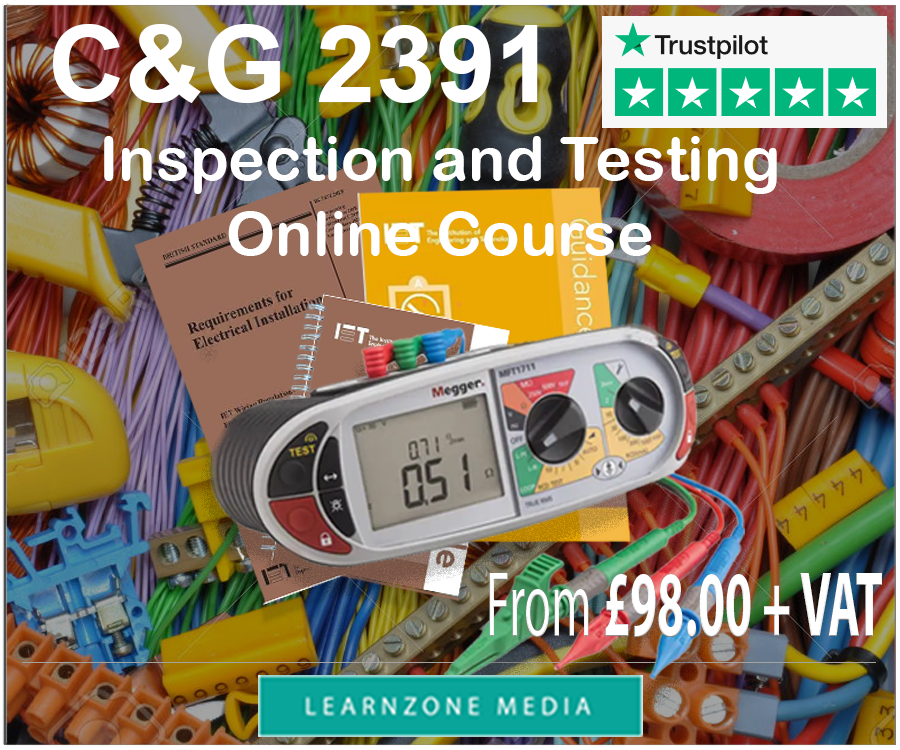C&G 2391 - Inspection and Testing
In this guide to Inspection and Testing you will learn about:
- testing procedures,
- sequence of tests,
- qualifications needed
-
and other things regarding the C&G 2391 exam.
What is Inspection and Testing?
Electrical Inspection and Testing is a procedure completed by qualified electricians.
Electrical installations that comply with BS 7671 are likely to satisfy Statutory Regulations such as the Electricity at Work Regulations 1989. Not to comply is a criminal offence and could result in a hefty fine or imprisonment.
Inspection and testing on completion of a new installation
Within BS 7671, Regulation 610.1 states that "every installation shall, during erection and on completion before being put into service be inspected and tested to verify , so far as reasonably practicable, that the requirements of the regulations have been met."
To comply with this regulation, qualified electricians must complete a full inspection and testing procedure. In a case of a new electrical installation, the procedure is followed by the completion of the Electrical Installation Certificate. In a case of an alteration of an existing electrical installation, a Minor Electrical Work Certificate is to be completed.
Periodic inspection and testing
Regulation 621.1 states that "where required, periodic inspection and testing of every electrical installation shall be carried out in accordance with regulations 621.2 to 621.5 in order to determine as far as reasonably practicable, whether the installation is in a satisfactory condition for continued service".
This regulation relates to electrical installations which are not newly built or altered. In this case a periodic inspection is to be carried out. Together with visual inspection it consists of a full inspection and testing procedure and is followed by the completion of the Electrical Installation Condition Report (EICR).
These certificates are documents which must be kept by both the "person ordering the work" (i.e.: owner) and the "competent person"(qualified electrician) completing the inspection and testing procedure.
Important things to remember:
![]() We need to inspect and test electrical installations to ensure compliance with BS7671, which is a NON-STATUTORY document.
We need to inspect and test electrical installations to ensure compliance with BS7671, which is a NON-STATUTORY document.
![]() By complying with BS7671, we are also complying with HASAWA 1974 and EAWR 1989, both STATUTORY documents.
By complying with BS7671, we are also complying with HASAWA 1974 and EAWR 1989, both STATUTORY documents.
The Inspection and Testing Procedure
To comply with regulations set in BS 7671, qualified electricians must complete a correct and suitable Inspection and Testing procedure.
This procedure consists of both visual inspection and tests carried out with the help of suitable testing equipment, such as the Megger 1553 multifunctional tester.
The electrical installation to be inspected can be eider a new build/alteration, in which case an Initial Verification Inspection and Testing procedure must be completed, or an existing electrical installation, in which case a Periodic Inspection and Testing procedure needs to be completed. On the following pages you can learn more about both of these electrical testing procedures.
In both cases the sequence of tests to be carried are the same.
Sequence of tests
During both initial verification and periodic inspection, each circuit must be tested. It is very important that the sequence of tests is carried out in a correct order.
The sequence of tests:
- Continuity of protective conductors, including main and supplementary bonding
- Continuity of ring final circuit conductors
- Insulation resistance
testing
- Polarity testing
- Earth fault loop impedance testing
- Prospective fault current testing
- RCD testing
- Phase sequence testing
- Functional testing
You can learn about each of these testing procedures in detail on the following pages.





